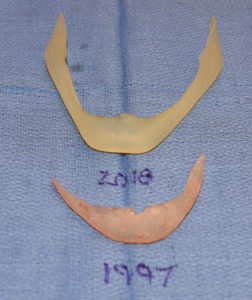Facial implants have been around as a common aesthetic facial procedure for about three decades. Over this time many different styles and sizes of facial implants have become commercially available and they do satisfy may modest to moderate aesthetic facial bone deficiencies.
But not every aesthetic facial volume need can be meet with the use of standard implants due to either size requirements or asymmetries. As a result, the concept of custom facial implants has been employed for these types of patients to better serve their facial aesthetic needs.
Originally the concept of customizing a facial implant was to simply take a standard implant and modify it during surgery. While that concept is still done today the true definition of a ‘custom facial implant’ is when the implant needs to be bigger or cover more bone surface area that a standard one does. This became possible in the 1990s when the first 3D CT scans and implant models from them could be made. From these patient models the implant was designed in wax or clay by hand from which a mold was made and then were then made in solid silicone material.
Over the past twenty years computer technology and design software has made it possible to do the entire implant design process on the computer from from the patient’s 3D CT scan from which the implant can then be made. This is obviously a far more precise implant design method that is also faster and is the standard method used today.

As such improvement has been seen in the past twenty years in custom facial implants design and fabrication, how will it evolve in the next twenty years? Most likely it will be the ability to create a design and out the soft tissue back on the bones and see what the result will really look like. This will aid the custom implant design process immensely as that is the one variable that still remains more artistic than scientific today.
Dr. Barry Eppley
Indianapolis Indiana


